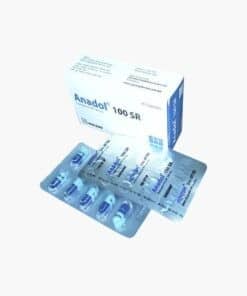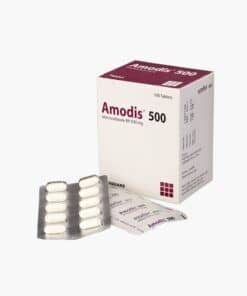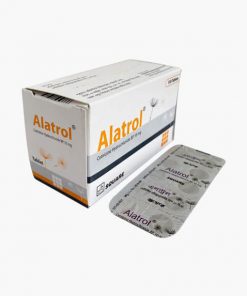Relafin | Tablet | 50 mg | 10 pcs
৳ 151.10
Brand Name: Relafin Tablet
Generic: Fluvoxamine Maleate
50 mg
Manufacturer: General Pharmaceuticals Ltd.
Unit Price: ৳ 15.11 (3 x 10: ৳ 453.30)
Strip Price: ৳ 151.10
Indications
Obsessive-Compulsive Disorder: Fluvoxamine Maleate are indicated for the treatment of obsessions and compulsions in patients with obsessive compulsive disorder (OCD), as defined in DSM-III-R or DSM-IV. The obsessions or compulsions cause marked distress, are time-consuming, or significantly interfere with social or occupational functioning.
Obsessive compulsive disorder is characterized by recurrent and persistent ideas, thoughts, impulses or images (obsessions) that are ego-dystonic and/or repetitive, purposeful, and intentional behaviors (compulsions) that are recognized by the person as excessive or unreasonable.
Therapeutic Class
Pharmacology
The mechanism of action of fluvoxamine maleate in obsessive compulsive disorder is presumed to be linked to its specific serotonin reuptake inhibition in brain neurons. Fluvoxamine has been shown to be a potent inhibitor of the serotonin reuptake transporter in preclinical studies, both in vitro and in vivo.
In in vitro studies, fluvoxamine maleate had no significant affinity for histaminergic, alpha or beta adrenergic, muscarinic, or dopaminergic receptors. Antagonism of some of these receptors is thought to be associated with various sedative, cardiovascular, anticholinergic, and extrapyramidal effects of some psychotropic drugs.
Dosage & Administration
Adults: The recommended starting dose for Fluvoxamine Maleate Tablets in adult patients is 50 mg, administered as a single daily dose at bedtime. In the controlled clinical trials establishing the effectiveness of Fluvoxamine Maleate Tablets in OCD, patients were titrated within a dose range of 100 to 300 mg/day. Consequently, the dose should be increased in 50 mg increments every 4 to 7 days, as tolerated, until maximum therapeutic benefit is achieved, not to exceed 300 mg per day. It is advisable that a total daily dose of more than 100 mg should be given in two divided doses. If the doses are not equal, the larger dose should be given at bedtime.
Pediatric Population (children and adolescents): The recommended starting dose for Fluvoxamine Maleate Tablets in pediatric populations (ages 8-17 years) is 25 mg, administered as a single daily dose at bedtime. In a controlled clinical trial establishing the effectiveness of Fluvoxamine Maleate Tablets in OCD, pediatric patients (ages 8-17) were titrated within a dose range of 50 to 200 mg/day. Physicians should consider age and gender differences when dosing pediatric patients. The maximum dose in children up to age 11 should not exceed 200 mg/day. Therapeutic effect in female children may be achieved with lower doses. Dose adjustment in adolescents (up to the adult maximum dose of 300 mg) may be indicated to achieve therapeutic benefit. The dose should be increased in 25 mg increments every 4 to 7 days, as tolerated, until maximum therapeutic benefit is achieved. It is advisable that a total daily dose of more than 50 mg should be given in two divided doses. If the two divided doses are not equal, the larger dose should be given at bedtime.
Elderly Or Hepatically Impaired Patients: Elderly patients and those with hepatic impairment have been observed to have a decreased clearance of fluvoxamine maleate. Consequently, it may be appropriate to modify the initial dose and the subsequent dose titration for these patient groups.
Interaction
Co-admin with fluvoxamine may increase carbamazepine toxicity and serum levels of theophylline. Lithium enhances the serotonergic effects of fluvoxamine. Anticoagulants may require dosage adjustments. Diltiazem with fluvoxamine may lead to bradycardia. Avoid alcohol.
Potentially Fatal: Fluvoxamine should not be used in combination with MAOIs, or within 14 days of discontinuing treatment with MAOIs.
Contraindications
Side Effects
Pregnancy & Lactation
Precautions & Warnings
Use in Special Populations
Elderly Or Hepatically Impaired Patients: Elderly patients and those with hepatic impairment have been observed to have a decreased clearance of fluvoxamine maleate. Consequently, it may be appropriate to modify the initial dose and the subsequent dose titration for these patient groups.
Pregnant Women During The Third Trimester: Neonates exposed to Fluvoxamine Maleate Tablets and other SSRIs or SNRIs late in the third trimester have developed complications requiring prolonged hospitalization, respiratory support, and tube feeding and may be at risk for persistent pulmonary hypertension of the newborn (PPHN). When treating pregnant women with Fluvoxamine Maleate Tablets during the third trimester, the physician should carefully consider the potential risks and benefits of treatment.
Storage Conditions
| Generic Name | Fluvoxamine Maleate |
|---|---|
| Size | 50 mg |
Only logged in customers who have purchased this product may leave a review.











Reviews
There are no reviews yet.